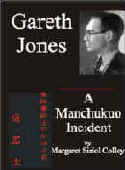Gareth Jones
[bas relief by Oleh Lesiuk]
HOME |
Stop Press |
Complete Soviet Articles & Background Information |
Précis of Gareth's
|
All Published Articles |
BOOKS
|
|
|
|
More Than Grain of Truth(2005) |
|
|
TOPICAL
'Are you Listening NYT?' U.N. Speech - Nov 2009 |
Gareth Recognised at Cambridge - Nov 2009 |
Reporter and the Genocide - Rome, March 2009 |
Order of Freedom Award -Nov 2008 |
Premiere of 'The Living' Documentary Kyiv - Nov 2008 |
Gareth Jones 'Famine' Diaries - Chicago 2008 |
Aberystwyth Memorial Plaque 2006 |
GENERAL
Scholarship Fund |
Site Map |
Links |
Legal Notices |
Sponsored Links |
Contact |
THE WESTERN MAIL
& SOUTH WALES NEWS, May 10th, 1933
War on Unemployment (vii)SWANSEA HOUSING LEADTOWNHILL CONTRAST TO DRAB STREETSSmall Amount of Slum Clearance to be DoneBy GARETH JONESThere are two ways of tackling the alum problem. The first is to go on building without waiting for the slums to be cleared away; the second is to attack the slums and to demolish the old dilapidated houses. Swansea has chosen the first method. On a steep hill overlooking the bay, where the air is fresh and healthy, stand the houses of Townhill, each house facing the south and bathed in sunlight. Built since the war on Sir Raymond Unwin’s plans, they bear witness to the energy with which the Swansea authorities have faced the housing problem. The spaces between the houses, the well-kept gardens, and the green patches provide light, air, and colour, while the varied nature and the different hues of the buildings are in striking contrast to the drab rows of streets which one can see beneath the hill. Since the war the Swansea Corporation has built 3,100 new houses, of which between 2,300 and 2,400 are in Townhill, and about 12,000 people have their homes on the height. The cost, however, has been exceedingly great, and it is estimated that about £3,000,000 has been contributed to better housing by the Swansea Corporation. A MODEL SCHOOLOne of the most striking schools I have ever seen stands on the hill, and those who revel in the schools of Fascist Italy after a short superficial visit or those who tell of the wonders of the Soviet schools should pay a visit to this Baptist Well Junior Boys’ School, which shows that Wales can build good schools without proclaiming them as miracle, to the world. Boldly facing the sweep of the sea, constructed in semi-circular form, it is so situated as to give light and air to each classroom and to provide a living map of Swansea stretched below. It adds ammunition to the argument that some of schools recently built in Wales are amongst the best in the world. What of the bad housing conditions. The bad areas are due to the age of Swansea. Whereas history may give the borough of Swansea dignity and prestige, it also places upon the town an inheritance of old dilapidated houses. Over one-third of the pre-war working class houses are 50 to 100 years old and some were built over a century ago. “How long have you lived in this honest?” I asked a women in GreenHill. She replied, “All my life, and my mother lived here all her life, and my grandmother, too. Our family has been here a hundred years.” DOWN THE STRANDThese old houses suffer from decrepitude, disrepair, and dampness. If we visit some of the dwellings in the strand we see how small, many of the windows are, how threatening some of the cracks in the ceiling appear, how narrow the staircases are which lead to the bedrooms above, and how, in some bedrooms one has to bow one’s head to avoid hitting it against a damp, sloping roof. In old Swansea one sees that the yards are small, and that some are built up almost against the earth slope in the back and lack back doors or back windows to provide through ventilation. The amount of slum clearance to be done is small, for there are few areas where there is sufficient air and light. The great task in Swansea is that of reconditioning the old houses, and much of this is necessary, for houses in Swansea show how reconditioning should and also should not be done. In Millrow there is a good example of re-conditioning, where two-roomed houses without a back door or back window have had a scullery and a bedroom with a big window added. Other houses in Greenhill which look clean and smart from the outside but which are damp and dilapidated inside show how re-conditioning should not be carried out. It is certainly no use to plaster the walls outside if inside the ceilings are cracking. THE MAIN TROUBLEIn re-conditioning houses the main troubles have been shortage of bedroom accommodation, no proper scullery, no well-ventilated food storage and lack of inside water service. The paving of the backyards is also important in re-conditioning. Where there is more than one family in the house the lack of amenities, such a. separate kitchens, is a difficulty, and it is often better to deal with this problem at once then to wait many years before a new house is available for the families. But whatever is done to build new houses, or to re-condition the old, the human element remains predominant. It is not only the slums which make the slum-dwellers but also the slum-dwellers who make the slums. There are dwellers who cannot live up to a civilised standard and who will turn the best of new houses into slums again. In the areas of bad housing, such as the Strand, Greenhill, and also the old Training College and also in the shacks of which a few have sprung up on the fringe of Swansea, there are many people who are below the usual level of intelligence and cleanliness. Many wish to cling to their old haunts. DO NOT LIKE TO GO“How would you like to go to a, new house?” I asked one old woman in the Strand area. She replied: “My mother died here, and I should like to be carried out of here, too.” Sometimes in a street where most occupiers live in bad conditions one finds a house where a clean, hard-working man has made good, clean home. The slum problem is, therefore, as much a human problem as it is one of building or demolishing houses, and can be dealt with by education, but educational methods are certainly helped by the improvement of the homes. Swansea has shown the way in Townhill. The old houses below must be tackled. |
|
||||||||
|
|||||||||




